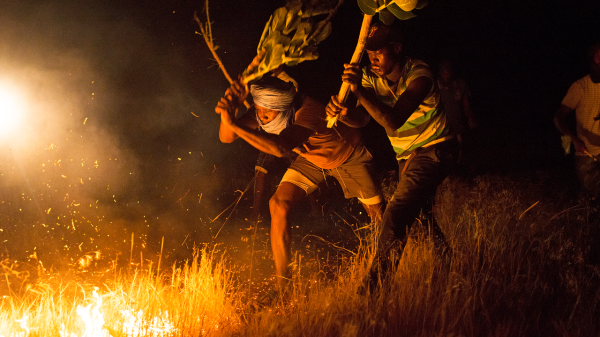
Save this storySave this storySave this storySave this story
“In these parts of the world, where people live in extremely rough circumstances, they’re able to put aside [their] differences in the name of protecting their environment,” the director David Alexander said.
A blaze at night in the Sahel, chased and beaten by nomads in flip-flops wielding fronds, opens David Alexander’s “The Fire Brigade.” The scene forces viewers to remember what planet they’re on, how quickly it can turn inhospitable, how alien it can seem. In the slow-motion shots, where the men appear as little more than silhouettes against a backdrop of smoldering brush, the fronds hit the flames, shooting sparks and embers into the air. The sequences have a strange beauty, even though they’re depicting the burning world.
The brigade putting out the flames mostly comprises refugees from Mali who live in the Mbera camp, in Bassikounou, Mauritania. Droughts in the nineteen-seventies and eighties, and armed conflict in the nineties, caused thousands of Malians to flee their country. Ahmedou Ag Albohary, the leader of the fire brigade, was among them, and he says that his countrymen have been left with “the shock of exile.” Today, Ag Albohary is one of more than a hundred thousand refugees hosted by Mauritania.
The New Yorker Documentary
View the latest or submit your own film.

Initially, there was a tension between the Malians, who had to clear acacias and other vegetation to build the camps, and their Mauritanian hosts. The Mauritanians mourned the clearing of the flora necessary for the camp, and accused the refugees of taking too much straw and wood, but Ag Albohary says that, once their hosts saw the Malians fighting brush fires, “they started considering us as their equals.” “In these parts of the world, where people live in extremely rough circumstances, they’re able to put aside these differences in the name of protecting their environment,” Alexander told me. His first filming trip took place in October, two years ago, at the start of fire season.
Ahmed Brahim O. Tyeb, a brigade volunteer, says that he’s seen desertification and land degradation intensify in his lifetime, owing to climate change. The film, then, is a glimpse of our shared future. By the end of this decade, scientists and models predict that hurricanes and droughts will push people across borders and into refugee camps, many of which will be in areas made flammable by desertification. Millions will live as these men do: in makeshift settlements in foreign lands, fighting brush fires with nothing but branches.
Still, Alexander is not presenting a one-tone portrait of desolation. Life in the refugee camps continues, sometimes resembling normalcy, even under the aegis of disaster. The quotidian gestures of the refugees—pouring tea, dipping bread in oil, herding cattle—captured by Alexander, emit a dignity borne of resilience.
To replenish what was cut to make way for the camp, the Malians have begun nurseries for desert flora. The scenes showing greenery in the desert are hopeful, almost sentimentally so. As Alexander told me, the film is “not just about putting out fires but also about putting roots in the ground and making things grow.”
Sourse: newyorker.com






